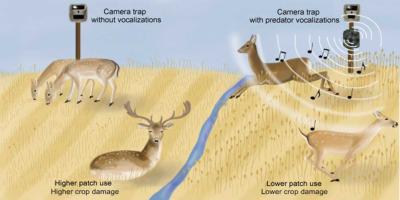Agriculture, Ecosystems & Environment ( IF 6.0 ) Pub Date : 2022-01-07 , DOI: 10.1016/j.agee.2022.107853 Anna Widén 1 , Michael Clinchy 2 , Annika M. Felton 3 , Tim R. Hofmeester 1 , Dries P.J. Kuijper 4 , Navinder J. Singh 1 , Fredrik Widemo 1 , Liana Y. Zanette 2 , Joris P.G.M. Cromsigt 1, 5

|
Wild ungulates are a major consumer of agricultural crops in human dominated landscapes. Across Europe, ungulate populations are leading to intensified human-wildlife conflicts. At the same time, ungulates play a vital role in the structuring and functioning of ecosystems, and are highly appreciated for recreational hunting. Thus, managers often face the challenge of maintaining the benefits of having thriving ungulate populations while simultaneously minimizing their negative impacts. Broadcasting playbacks of predator vocalizations (e.g. dogs barking, wolves howling or humans talking) could potentially be used to induce fear and thereby displace or steer behavior of ungulates from conflict-prone sites resulting in reduced visitation and foraging time and consumption. Predator playback experiments in wilderness areas have repeatedly demonstrated to reduce the preys´ resource use and impacts on the surrounding landscape, but this has not been tested in agricultural fields where human-ungulate conflicts are most pronounced. We responded to this need by conducting a predator playback experiment in multiple crop fields in southern Sweden, where multiple ungulate species (fallow deer, roe deer, red deer, moose, wild boar) coexist, using a novel integrated camera trap – speaker system (ABRs) that broadcasts sounds of choice when a camera is triggered by an ungulate. Predator playbacks (wolf, dog, human) reduced deer patch use and crop damage on wheat fields more than playbacks of control sounds (owl, goose, raven). Our results confirm findings from previous studies in wilderness areas, and demonstrate that broadcasting predator playbacks using ABRs may provide an effective tool to reduce crop damage at the scale and duration of our study.
中文翻译:

捕食者发声的回放可减少有蹄类动物对作物的损害
野生有蹄类动物是人类主导景观中农作物的主要消费者。在整个欧洲,有蹄类动物种群正在导致人类与野生动物之间的冲突加剧。同时,有蹄类动物在生态系统的结构和功能中发挥着至关重要的作用,并在休闲狩猎方面受到高度赞赏。因此,管理者经常面临挑战,既要保持拥有繁荣的有蹄类动物种群的好处,同时又要尽量减少它们的负面影响。播放捕食者的声音(例如狗吠、狼嚎或人类说话)可能会被用来诱发恐惧,从而取代或引导有蹄类动物从冲突多发地点的行为,从而减少访问和觅食时间和消耗。荒野地区的捕食者回放实验一再证明可以减少猎物的资源使用和对周围景观的影响,但这尚未在人与有蹄类动物冲突最明显的农业领域进行测试。我们通过在瑞典南部的多个农田进行捕食者回放实验来满足这一需求,在这些农田中,多种有蹄类动物(小鹿、狍、马鹿、驼鹿、野猪)共存,使用了一种新颖的集成相机陷阱 - 扬声器系统( ABRs),当有蹄类动物触发相机时广播选择的声音。捕食者回放(狼、狗、人类)比控制声音(猫头鹰、鹅、乌鸦)的回放更能减少鹿斑的使用和麦田对农作物的损害。我们的结果证实了之前在荒野地区的研究结果,









































 京公网安备 11010802027423号
京公网安备 11010802027423号